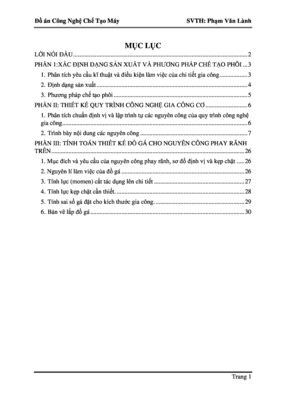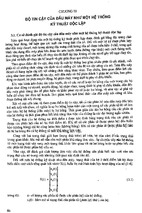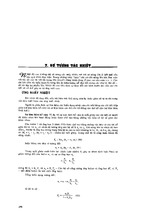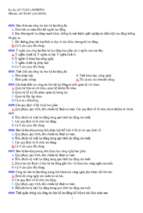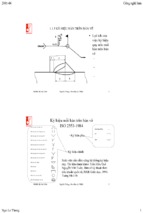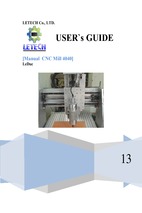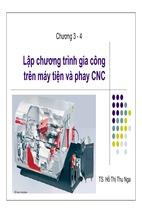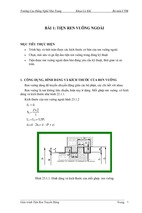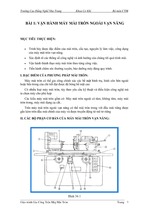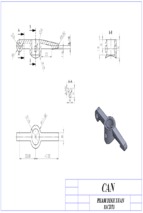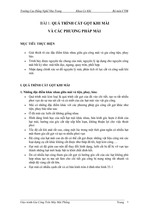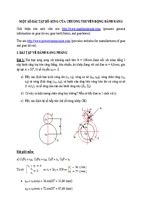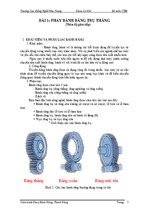Technician Handbook
874 Engine Control Systems II
Technical Training
169
Technician Handbook
874 Engine Control Systems II
Thermostat Monitor
The Thermostat Monitor measures the rate of coolant temperature rise. If
the ECT sensor does not detect a predetermined temperature at the ECT
sensor after a predetermined amount of time, the ECM will set one of
several DTCs depending on the malfunction. The best source of this
code-setting parameter information is the Repair Manual specific to the
vehicle. Carefully study the information to determine what must occur
before a DTC will be recorded and how to diagnose the issue. The DTC
may be the result of an out-of-spec system monitor, not a component that
has failed.
P0116: Engine Coolant Temperature Circuit Range/Performance Problem
P0125: Insufficient Coolant Temperature for Closed Loop Fuel Control
NOTE
Although the description in the Repair Manual for P0125 states
“insufficient coolant temp for closed loop fuel control,” this can be one
cause for no signal output from the O2 sensor. For most 2003 and earlier
vehicles, the P0125 DTC is not a result of the thermostat monitor, and
may correspond with O2 sensor heater malfunctions. For most 2004 and
later vehicles, the P0125 DTC is a direct result of the thermostat monitor
and corresponds with incorrect engine coolant temperature.
P0128: Coolant Thermostat (Coolant Temperature Below Thermostat
Regulating Temperature)
Thermostat Monitor
Diagnosis
170
When trying to determine the cause of a Thermostat Monitor issue,
check the Freeze Frame data and duplicate the conditions. Use the
Technical Information System (TIS) for Repair Manual (RM) and Electrical
Wiring Diagram (EWD) information, and look for applicable Service
Bulletins (SB).
Technical Training
Technician Handbook
874 Engine Control Systems II
Exhaust Gas
Recirculation (EGR)
System Overview
NOTE
Exhaust Gas Recirculation
(EGR) System Monitor
The EGR system routes a small amount of exhaust gases back into
the intake manifold, during certain engine operating conditions, to
lower combustion chamber temperature and pressure. This helps
control engine knock and reduces oxides of nitrogen emissions.
Most vehicles equipped with VVT-i or Dual VVT-i systems will not
utilize an EGR system.
The EGR system is monitored because a system failure can affect
emissions. The EGR valve position/temperature detection
monitoring method is utilized to detect:
• Level of EGR flow (too much or too little)
• Component performance
• Sensor opens and shorts
EGR DTCs (both 2-trip detection) are:
• P0401: Insufficient Flow ECM compares EGR temperature to
IAT when EGR valve is open. Low EGR temperature is
interpreted as a system fault.
• P0402: Excessive Flow ECM monitors EGR valve height
position sensor. If EGR is off but sensor signals that valve is
open, ECM assumes the valve did not close.
Exhaust Gas Recirculation
(EGR) System Diagnosis
When trying to determine the cause of an EGR system issue, check
the Freeze Frame data and duplicate the conditions. Use the
Technical Information System (TIS) for Repair Manual (RM) and
Electrical Wiring Diagram (EWD) information, and look for
applicable Service Bulletins (SB).
NOTE
If the vehicle has been repaired in the past, verify that all EGR valve
vacuum lines are routed correctly.
Technical Training
171
Technician Handbook
874 Engine Control Systems II
VVT-i Diagnosis
The variable valve timing system is designed to control the intake and
exhaust (on some systems) camshaft(s) to provide valve timing that is
optimally suited to the engine conditions. This improves torque in all
speed ranges, as well as increased fuel economy and reduced
exhaust emissions. Camshaft timing is varied based on engine
operating conditions such as intake air volume, throttle position, and
engine coolant temperature. The ECM checks the actual valve timing
based on input from the camshaft position sensor and the crankshaft
position sensor.
There are several types of variable valve timing systems in use on
Toyota and Lexus vehicles, including VVT-i, Dual VVT-i, and VVT-iE. It
is essential that the VVT system be correctly identified before
beginning diagnosis. The best source for identifying the VVT system
on a specific vehicle is the Repair Manual.
VVT-i
The VVT-i system phases only the intake camshaft and includes the
ECM, the oil control valve (OCV), and the VVT controller (on the
camshaft). The ECM controls the OCV duty-cycle, which in turn
regulates the oil pressure supplied to the VVT controller. Because the
VVT-i system relies on oil pressure to operate, valve timing will not be
optimized when the engine is cold or at low engine speeds.
Dual VVT-i
VVT-iE
172
The Dual VVT-i system phases both the intake and exhaust camshafts
and includes the same components as the VVT-i on all camshafts.
The VVT-iE system uses electric motors to phase the intake
camshafts. The exhaust camshaft is phased using the same
components as the VVT-i system. Because the intake camshaft is
phased by electric motors, it can optimize valve timing even when the
engine oil pressure is low, such as when the engine oil temperature or
the engine speed is low.
Technical Training
Technician Handbook
874 Engine Control Systems II
VVT-i Monitors
The VVT systems are monitored for many malfunctions. Always refer to the
Repair Manual for specific system DTC and monitor information. The
following is a summary of the Dual VVT-i system monitors:
Camshaft Position
Over-Advanced, OverRetarded, or System
Performance
The ECM sends a target duty-cycle control signal to the OCV. This control
signal regulates the oil pressure supplied to the VVT controller. The VVT
controller can advance or retard the intake camshaft. If the difference
between the target and actual intake valve timing is large, and changes in
the actual intake valve timing are small, the ECM interprets this as the VVT
controller stuck malfunction and sets a DTC. See the Repair Manual for
DTC information and monitor enabling conditions and details.
Crankshaft Position –
Camshaft Position
Correlation
To monitor the correlation of the intake camshaft position and crankshaft
position, the ECM checks the VVT learning value while the engine is idling.
The VVT learning value is calibrated based on the camshaft position and
crankshaft position. The intake valve timing is set to the most retarded
angle while the engine is idling. The exhaust valve timing is set to the most
advanced angle while the engine is idling. If the VVT learning value is out of
the specified range in consecutive driving cycles, the ECM illuminates the
MIL and sets a DTC. See the Repair Manual for DTC information and
monitor enabling conditions and details.
Camshaft Position
Sensor Circuit
If no signal is transmitted by the VVT sensor despite the engine revolving,
or the rotations of the camshaft and the crankshaft are not synchronized,
the ECM interprets this as a malfunction of the sensor and sets a DTC. See
the Repair Manual for DTC information and monitor enabling conditions
and details.
Camshaft Position
Actuator Circuit
After the ECM sends the “target” duty-cycle signal to the OCV, the ECM
monitors the OCV current to establish an “actual” duty-cycle. The ECM
detects a malfunction and sets a DTC when the actual duty-cycle ratio
varies from the target duty-cycle ratio. See the Repair Manual for DTC
information and monitor enabling conditions and details.
Technical Training
173
Technician Handbook
874 Engine Control Systems II
VVT Diagnosis
When trying to determine the cause of a VVT system issue, check the
Freeze Frame data and duplicate the conditions. Use the Technical
Information System (TIS) for Repair Manual (RM) and Electrical
Wiring Diagram (EWD) information, and look for applicable Service
Bulletins (SB).
Active Tests
NOTE
174
Active tests can be performed to check the VVT system. Different
active tests will be available depending on the VVT system. Typically,
when the valve timing is changed at idle with an active test, the
engine will run rough or may die. Refer to the Repair Manual for the
proper VVT active test response and diagnostic procedure.
Check the vehicle service history. If the vehicle has been repaired in
the past, check for improperly installed timing belts, components, etc.
Technical Training
Technician Handbook
874 Engine Control Systems II
ETCS-i Overview
Instead of a conventional cable connecting the driver-operated throttle
pedal to the engine throttle valve, the latest ETCS-i systems allow the
ECM to adjust throttle angle in response to engine and vehicle conditions.
The accelerator pedal position sensor detects accelerator pedal position
(driver controlled) and signals the ECM. The ECM drives the throttle
motor to change throttle valve position. The throttle position sensor
detects throttle valve angle and confirms to the ECM that the desired
throttle valve position is achieved. Both the accelerator pedal position
sensor and the throttle position sensor have two sensing elements.
ETCS-i Monitor
ETCS-i Diagnosis
The ECM uses two accelerator position sensors and two throttle position
sensors to verify proper operation of the position sensors and to monitor
the commanded versus actual throttle valve opening angle.
When trying to determine the cause of an ETCS-i issue, check the Freeze
Frame data and duplicate the conditions. Use the Technical Information
System (TIS) for Repair Manual (RM) and Electrical Wiring Diagram
(EWD) information, and look for applicable Service Bulletins (SB).
The Techstream can display data readings from both sensing elements of
the accelerator pedal position sensor and throttle position sensor.
Compare actual sensor signals to specifications, with throttle pedal
released and depressed. Normal signals indicate that sensors and all
related circuits are operating correctly. Out-of-specification signals lead to
wiring and component DVOM testing.
Active tests can be performed to check the ETCS-i system. Refer to the
Repair Manual for the proper ETCS-i Active Test response and diagnostic
procedure.
Technical Training
175
Technician Handbook
874 Engine Control Systems II
PZEV Overview
Early PZEV Vehicles
NOTE
Late PZEV Vehicles
NOTE
PZEV Diagnosis
Under CARB PZEV requirements, the tailpipe emissions must meet the
SULEV (Super Ultra-Low Emission Vehicle) regulations and the evaporative
emissions must meet the PZEV (Partial Zero Emission Vehicle) regulations.
Go to http://www.epa.gov/otaq/stds-ld.htm for more information on light-duty
vehicle emissions regulations. The warranty for emissions components is
increased to 150,000 miles (California). Some manuals may refer to the PZEV
vehicle as having the “California Package.” While most PZEV vehicles will be
sold and operated in California, they may show up in your shop.
The differences between early model (2003–2006) PZEV and conventional
vehicles are: an Intake Manifold Valve Assembly (IMVA), which is attached to a
revised intake manifold, is incorporated; the front TWC is a close-coupled type
(closer to exhaust ports for faster warm-up); the Toyota HCAC (Hydrocarbon
Adsorptive Catalyst) is utilized as the rear TWC; two post-catalyst O2 sensors
are used [one after the front TWC (S2 position) and one after the rear TWC
(S3 position)]; and the EVAP system incorporates a larger canister and a new
trap canister.
Some early model PZEV vehicles may have two banks (B1 and B2) for a 4cylinder engine.
The differences between later model (2006 and later) PZEV and conventional
vehicles are: an Intake Manifold Valve Assembly (IMVA), which is attached to a
revised intake manifold, is incorporated; and the front catalyst is a closecoupled type.
Components for PZEV vehicles and conventional vehicles are not
interchangeable. Verify correct part numbers, tag colors, electrical connector
colors and shapes, etc. before installing new parts.
When trying to determine the cause of a PZEV vehicle issue, check the Freeze
Frame data and duplicate the conditions. Use the Technical Information
System (TIS) for Repair Manual (RM) and Electrical Wiring Diagram (EWD)
information, and look for applicable Service Bulletins (SB).
Use the Repair Manual (RM) and New Car Features (NCF) manual to identify
component locations and components that may be different than a
conventional vehicle.
176
Technical Training
Technician Handbook
874 Engine Control Systems II
ECM Diagnosis
Overview
The ECM is rarely the cause of a problem. On rare occasions, you
will find that the Malfunction Indicator Lamp or the Techstream fails
to operate properly. Before connecting your Techstream it is
important to confirm that the Malfunction Indicator Lamp (MIL) is
functioning normally. A bulb check of the MIL is performed when the
ignition is switched ON. If the MIL does not illuminate, it indicates
that a problem exists in the MIL subsystem. This condition must be
corrected before any further diagnostic work can be performed. See
the diagnostic procedures for inoperative MIL in the Repair Manual.
Once the engine is started, the MIL should turn OFF. If the MIL
remains ON after the engine is running, the diagnostic system has
detected a malfunction in the engine control system.
Failure of Techstream to
Establish Communications
with ECM
There are several possibilities when the Techstream fails to
communicate with the vehicle. The problem could simply be the way
you programmed the tester, or connecting to the wrong DLC. Once
you have confirmed correct programming and proper lead
connection, you will need to establish whether the problem is in the
tester or the diagnostic circuit. To isolate a tester problem from a
vehicle problem, simply try the tester on another vehicle. If the tester
communicates normally with another vehicle, it is probably OK and
the vehicle diagnostic system must be inspected.
ECM Circuit Diagnosis
If the MIL illuminates when the ignition is switched to the ON
position, the Main Relay is functional and current is flowing to the
ECM +B terminals. If the MIL does not illuminate, use a voltmeter to
monitor the +B terminal of DLC1. If battery voltage is available at the
DLC1 +B terminal, the Main Relay is functional. Further circuit
troubleshooting will be required to determine if current is flowing to
the ECM. Consult the Repair Manual. Refer to the appropriate
Repair Manual circuit inspection charts and to the Engine Control
System schematic in the EWD for troubleshooting details.
Technical Training
177
Technician Handbook
874 Engine Control Systems II
ECU Reprogramming
Beginning with some 2001 model year vehicles, the ECM is capable
of being reprogrammed. It is called ECU reprogramming because
this procedure may be applicable for multiple processors. This
procedure allows the ECM to be updated on an as-needed basis
without replacement.
If there is a calibration update available for a certain ECU on a
vehicle, a linked “Yes” will be present in the Cal. Update? column of
the particular ECU row within the Health Check Results screen
(after a Health Check is performed). Clicking on the linked result will
open TIS. The Service Bulletin (SB) related to the issue will be
available and will provide the necessary reprogramming information
and procedure.
NOTE
ECU Reprogramming Tips
It is critically important that the TSB be followed exactly and in its
entirety to avoid damage or creating other problems.
• If a Recalibration Label is present, the vehicle has already
been recalibrated and no further action is required.
• The ECU calibration program is confirmed using the
Techstream.
• Check battery voltage. To avoid battery fluctuations while
reprogramming the Engine ECU, turn OFF all electrical
accessories (i.e. radio, lights, interior fan). Confirm battery
voltage is greater than 11.5V. Charge battery as necessary.
NOTE
178
If battery voltage drops below 11.4V during ECU recalibration,
damage to the Engine ECU will occur.
Technical Training
Technician Handbook
874 Engine Control Systems II
NOTE
The GR-8 battery charger includes a Power Supply mode designed
to keep the battery at a constant 13.5 V and eliminate current spikes
during ECU reprogramming. To enter this mode, turn the GR-8 ON
login Main Menu Power Supply.
• Ensure that all electrical systems are turned OFF and doors
and trunk are closed. Once the recalibration process has
started, do not operate the doors or accessories.
• Recalibration can take up to 45 minutes. The length of time to
reprogram will vary, depending on the type of ECM and
reprogram file.
• Do not move the Techstream or cable during recalibration to
prevent recalibration failures.
• Confirm that the new recalibration has successfully installed.
• If applicable, attach a new Recalibration Label.
Technical Training
179
Technician Handbook
874 Engine Control Systems II
VC Circuit
Diagnosis
180
The VC Circuit provides a constant 5V to many engine control
sensors and components. If this circuit is shorted to ground, all
sensors using this circuit for their 5V reference will show low
readings (0V from signal wire) that do not change during any
condition. Typically, the engine will not run with this condition or may
run very rough or die often and the Techstream may not be able to
communicate with the ECM. Sometimes, no DTCs will be present
with this condition. This condition sometimes occurred on early
model vehicles because the VC circuit was shorted to ground
internally in the vapor pressure sensor. Simply unplugging the VPS
returned all other sensors to normal operation and allowed the
engine to run properly. If an engine is not running or is running very
rough or dying and all sensors are showing shorted conditions (0V
from signal wire), this may require diagnosis of the VC circuit.
Technical Training
Technician Handbook
874 Engine Control Systems II
Immobiliser System
Overview
The immobiliser system is a theft deterrent system that determines
whether to disable the SFI system based on a comparison of the key’s
ID codes and the vehicle’s pre-registered code. If the ID codes do not
match, the immobiliser system deactivates, and the SFI system and the
engine cannot be started. There are many different immobiliser systems
in use.
When the Transponder Key ECU assembly detects that the key unlock
warning switch is ON, the ECU provides current to the transponder key
coil and produces a faint electric wave. A transponder chip in the key
receives this wave, and in turn outputs a key ID code signal. The
Transponder Key coil receives the signal, the transponder key amplifier
amplifies the signal, and the signal is then transmitted to the ECU.
The ECU matches the key’s ID codes with the vehicle’s ID code
(previously registered in the ECU), and sends the results to the ECM.
When the identification results show that the key’s ID code matches the
vehicle’s ID code (and after the ECU has confirmed this match), the
immobilizer system does not engage, allowing engine controls to
function for fuel and spark control. The ECU also transmits a security
signal that communicates “indicator OFF” to the Theft Warning ECU,
and the security light turns OFF.
Immobiliser System
Diagnosis
When trying to determine the cause of an immobiliser issue, use the
Technical Information System (TIS) for Repair Manual (RM) and
Electrical Wiring Diagram (EWD) information, and look for applicable
Service Bulletins (SB).
Immobiliser System
Diagnosis Tips
When starting the vehicle, make sure the key light (image in illustration)
on the instrument cluster turns OFF. If the light does not turn OFF, this
may indicate a problem with the immobiliser system. The ECM may set
DTCs for immobiliser issues. Refer to the Repair Manual (RM) for the
proper diagnostic procedure.
Technical Training
181
Technician Handbook
874 Engine Control Systems II
Hybrid Systems
If an engine control issue is present on a hybrid vehicle, it may be
necessary to place the vehicle into Inspection Mode. This will keep the
engine running at all times so that diagnosis can be performed.
Refer to the Repair Manual (RM) for the proper Inspection Mode
procedure.
The following is a general procedure to place hybrid vehicles into
Inspection Mode:
1. Turn the ignition switch ON.
2. Fully depress the accelerator pedal twice with the transmission in
the P position.
3. Fully depress the accelerator pedal twice with the transmission in
the N position.
4. Fully depress the accelerator pedal twice with the transmission in
the P position.
5. Check that the “MAINTENANCE MODE” on the multi-information
display and master warning light is illuminated in the combination
meter.
6. Put the vehicle in READY mode.
NOTE
To exit out of Inspection Mode, turn the ignition switch OFF.
NOTE
It is not recommended to drive the vehicle in Maintenance Mode as
damage to hybrid components will occur.
Hybrid System Diagnosis
When trying to determine the cause of an engine control issue on a
hybrid vehicle, check the Freeze Frame data and duplicate the
conditions. Use the Technical Information System (TIS) for Repair
Manual (RM) and Electrical Wiring Diagram (EWD) information, and
look for applicable Service Bulletins (SB).
182
Technical Training
Technician Handbook
874 Engine Control Systems II
Technical Training
183
- Xem thêm -


